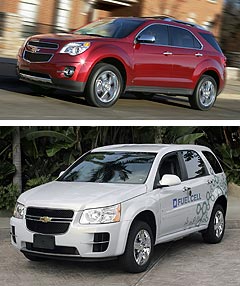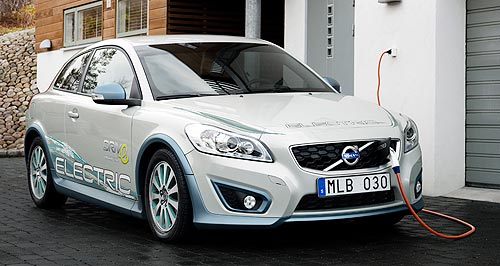Future models - Volvo - C30 - DRIVe ElectricVolvo extends EV range with fuel cell techElectric twist: Volvo is using the C30 DRIVe Electric as the basis for its radical range-extending hybrid program, which can extend the EV’s driving range by up to 250km. Volvo rethinks range-extending hybrid technology with radical C30 EV-based program28 Oct 2010 By TERRY MARTIN VOLVO has begun work on a radical new fuel cell system to extend the driving range of its electric vehicles. Based on the C30 DRIVe Electric car, which is in real-world testing ahead of wider-scale production in 2011, the new system will act as a range-extender in a similar way to plug-in hybrids such as the Chevrolet/Holden Volt, but with an interesting twist: it will be designed to break down petrol to create hydrogen gas and drastically reduce carbon dioxide emissions. According to Volvo, two prototype vehicles should be ready for testing in everyday traffic in 2012 using a system that combines a fuel cell with a “reformer” that breaks down a liquid fuel – in this case petrol, but renewable fuels will also be suitable – to create hydrogen gas. Specific technical details are still to be provided, but the claims indicate that little or no petrol is burned in the process. In the fuel cell, the gas is converted into electrical energy, which is used to power the C30’s 82kW electric motor.  Left: Chevrolet Equinox Fuel Cell Electric Vehicle (FCEV) SUV. Left: Chevrolet Equinox Fuel Cell Electric Vehicle (FCEV) SUV.“The technology generates electricity completely without any emissions of carbon oxide, nitrogen oxides, sulphur oxides and particles,” says Volvo. “Due to the highly efficient process, emissions of carbon dioxide are significantly reduced compared with a conventional vehicle. The end products are electricity, water and a small amount of carbon dioxide.” Developed in collaboration with Powercell Sweden AB, the fuel cell range extender is expected to increase the C30 DRIVe Electric’s operating range by up to 250km. The current C30-based EV uses a 24kWh lithium-ion battery (of which 22.7kWh is used to power the car) and has a driving range of 150km on a single charge, based on the New European Driving Cycle (NEDC). With the range-extending technology, this could increase to 400km. It should also dispense with the need for hydrogen fuel tanks to be packaged into the vehicle, and will not rely on a hydrogen refuelling infrastructure, which is one of the biggest sticking points to hydrogen’s adoption beyond a small number of cities. This is despite companies such as Honda, Mazda and BMW continuing to invest heavily in the development of hydrogen-powered vehicles, believing that it remains a viable future technology. The new range-extending technology, which is also being supported by the Swedish Energy Agency, is still to be proven for real-world automotive applications, but highlights Volvo’s intention to remain competitive, if not class-leading, in key areas such as alternative powertrains under its new owner, China’s Zhejiang Geely Holding Group Co. If feasible, and with the expectation that “the cost efficiency will improve continuously through refined technology and large-scale production”, the technology could also become a significant part of Volvo’s expansion into growth markets such as China. Volvo has committed to increasing production in China, with recently appointed president and CEO Stefan Jacoby also revealing this week that the company may build vehicles at as many as three plants in the world’s biggest automotive market, although it has not yet announced specific details or timeframes. Mr Jacoby described the new fuel cell project as “an exciting expansion of our focus on electrification”. “Battery cost and size means that all-electric cars still have a relatively limited operating range,” he said. “Fuel cells may be one way of extending the distance these cars can cover before they need to be recharged. What is more, the project gives us increased knowledge about fuel cells and hydrogen gas. “We have just taken the first steps and it is naturally too early to talk about market introduction of electric cars with range extenders. The industrial decision will come after we have learned more about fuel cells and the opportunities they offer,” he said. Volvo’s fleet testing program with the C30 DRIVe Electric currently encompasses about 250 vehicles, with scope to expand production if international demand continues at the same rate. However, as GoAuto reported earlier this month, a lack of public infrastructure and incentives compared with other countries has ruled it out for release in Australia any time soon. Volvo Cars’ special vehicles division director, Lennart Stegland, claims the current 150km driving range is “way further than 90 per cent of commuters in Europe cover on a daily basis” and that the car was suitable “for the average family’s everyday commuting needs”. Recharging of a completely depleted battery via a standard 230-volt mains power socket is said to take around eight hours. The car’s top speed is 130km/h, while 0-100km/h acceleration in completed in a claimed 10.5 seconds. “By 2020 about five to 10 per cent of cars in Sweden are expected to be electric,” Mr Stegland said. “By 2020 to 2025 we believe that electric cars will account for three to 10 per cent of the market share in the EU countries. Different markets have different preconditions.” Interestingly, 2025 is the date General Motors’ director of fuel cell commercialisation for the Asia Pacific region, George Hanson, has nominated as when fuel cell cars will cost the same as equivalent hybrid or range-extending vehicles. According to Britain’s Autocar, Mr Hanson predicts that huge cost reductions brought about by advances in materials and the volumes being produced will significantly drop the manufacturing cost of hydrogen-powered fuel cells. He also said that by 2025, infrastructure will have improved to the point where hydrogen refuelling stations will be commonplace, especially in hydrogen-advanced regions such as Germany, Korea, Japan and California. “Key to the fuel cell cost reductions is the amount of ultra-expensive platinum used in the powertrain,” Autocar reported. “Current fuel cell cars such as GM’s Equinox SUV use around 80g of the precious metal, whereas Hansen is predicting that by 2025 it will be reduced to around 2g – a similar amount to that currently used in a catalytic converter.” As GoAuto reported in March, GM claims to be on track to begin commercial production of hydrogen fuel cell vehicles by 2015. In recent months it has been testing a ‘production-intent’ system that can be packaged under the bonnet in the same space as a traditional four-cylinder engine. The system is said to be half the size, about 100kg lighter and uses about a third less platinum than the Equinox fuel-cell electric vehicle (FCEV), a prototype GM has been testing in the Project Driveway demonstration and evaluation program since late 2007. The lighter weight and compact dimensions will enable the US auto giant – which has invested more than $US1.5 billion into hydrogen fuel cell technology – to package the zero-emissions powertrain into any number of vehicles, from compact hatches to small and large sedans and crossover vehicles. The system is expected to be used initially in medium to large vehicles, with smaller models likely to come on stream toward the end of the decade.  Read more19th of October 2010  Rotary necessary for our future – Mazda chiefMazda commits to next-generation rotary in preparation for hydrogen society4th of October 2010  Australia to miss out on Volvo EV trialsVolvo baulks at electric C30 launch in Australia due to lack of support for EVs28th of June 2010  Riversimple sounds out Oz for fuel cell carUK ‘open-source’ hydrogen runabout on offer for Australian entrepreneursAll future models Alfa Romeo Alfa Romeo Abarth Abarth Audi Audi Aston Martin Aston Martin BMW BMW Bentley Bentley Chrysler Chrysler Chevrolet Chevrolet Dodge Dodge Citroen Citroen Ferrari Ferrari DS DS Ford Ford Fiat Fiat FPV FPV Foton Foton Haval Haval Great Wall Great Wall Honda Honda Holden Holden Hyundai Hyundai HSV HSV Isuzu Isuzu Infiniti Infiniti Jeep Jeep Jaguar Jaguar Lamborghini Lamborghini Kia Kia Lexus Lexus Land Rover Land Rover Mazda Mazda Maserati Maserati Mercedes-Benz Mercedes-Benz McLaren McLaren Mini Mini Nissan Nissan Mitsubishi Mitsubishi Peugeot Peugeot Opel Opel Proton Proton Porsche Porsche Renault Renault Ram Ram Saab Saab Rolls-Royce Rolls-Royce Smart Smart Skoda Skoda Subaru Subaru SsangYong SsangYong Tesla Tesla Suzuki Suzuki Toyota Toyota Volvo VolvoMotor industry news |
Click to shareVolvo modelsResearch Volvo All future models Alfa Romeo Alfa Romeo Abarth Abarth Audi Audi Aston Martin Aston Martin BMW BMW Bentley Bentley Chrysler Chrysler Chevrolet Chevrolet Dodge Dodge Citroen Citroen Ferrari Ferrari DS DS Ford Ford Fiat Fiat FPV FPV Foton Foton Haval Haval Great Wall Great Wall Honda Honda Holden Holden Hyundai Hyundai HSV HSV Isuzu Isuzu Infiniti Infiniti Jeep Jeep Jaguar Jaguar Lamborghini Lamborghini Kia Kia Lexus Lexus Land Rover Land Rover Mazda Mazda Maserati Maserati Mercedes-Benz Mercedes-Benz McLaren McLaren Mini Mini Nissan Nissan Mitsubishi Mitsubishi Peugeot Peugeot Opel Opel Proton Proton Porsche Porsche Renault Renault Ram Ram Saab Saab Rolls-Royce Rolls-Royce Smart Smart Skoda Skoda Subaru Subaru SsangYong SsangYong Tesla Tesla Suzuki Suzuki Toyota Toyota Volvo VolvoMotor industry news |
















Facebook Twitter Instagram